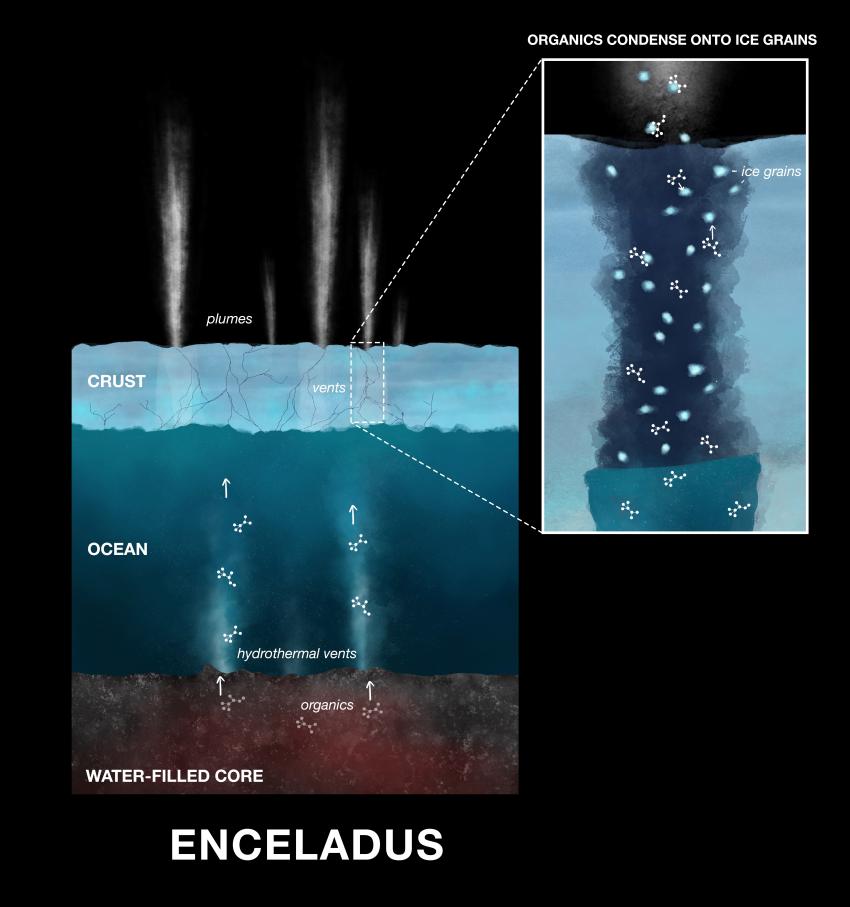On Earth hydrothermal vents on the ocean floor provide the energy that fuels reactions that produce amino acids, the building blocks of life. Scientists believe Enceladus' hydrothermal vents may operate in the same way, supplying energy that leads to the production of amino acids.
New kinds of organic compounds, the ingredients of amino acids, have been detected in the plumes bursting from Saturn's moon Enceladus. The findings are the result of the ongoing deep dive into data from the NASA-ESA mission Cassini-Huygens. A team of scientists led by Nozair Khawaja of the Free University of Berlin, publish the work in a new paper in Monthly Notices of the Royal Astronomical Society.
Powerful hydrothermal vents eject material from Enceladus' core, which mixes with water from the moon's massive subsurface ocean before it is released into space as water vapour and ice grains. The newly discovered molecules, condensed onto the ice grains, were determined to be nitrogen- and oxygen-bearing compounds.
On Earth, similar compounds are part of chemical reactions that produce amino acids, the building blocks of life. Hydrothermal vents on the ocean floor provide the energy that fuels the reactions. Scientists believe Enceladus' hydrothermal vents may operate in the same way, supplying energy that leads to the production of amino acids.
"If the conditions are right, these molecules coming from the deep ocean of Enceladus could be on the same reaction pathway as we see here on Earth. We don't yet know if amino acids are needed for life beyond Earth, but finding the molecules that form amino acids is an important piece of the puzzle," said Khawaja.
Although the Cassini-Huygens mission ended in September 2017, the data it provided will be mined for decades. Khawaja's team used data from the spacecraft's Cosmic Dust Analyser, or CDA, which detected ice grains emitted from Enceladus into Saturn's E ring.
The scientists used the CDA's mass spectrometer measurements to determine the composition of organic material in the grains.
The identified organics first dissolved in the ocean of Enceladus, then evaporated from the water surface before condensing and freezing onto ice grains inside the fractures in the moon's crust, scientists found. Blown into space with the rising plume emitted through those fractures, the ice grains were then analysed by Cassini's CDA.
The new findings complement the team's discovery last year of large, insoluble complex organic molecules believed to float on the surface of Enceladus' ocean. The team went deeper with this recent work to find the ingredients, dissolved in the ocean, that are needed for the hydrothermal processes that would spur amino acid formation.
"Here we are finding smaller and soluble organic building blocks — potential precursors for amino acids and other ingredients required for life on Earth," said co-author Jon Hillier.
"This work shows that Enceladus' ocean has reactive building blocks in abundance, and it's another green light in the investigation of the habitability of Enceladus," added co-author Frank Postberg.
Media contacts
Gretchen McCartney
Jet Propulsion Laboratory, Pasadena, California, USA
Tel: +1 818-393-6215
gretchen.p.mccartney@jpl.nasa.gov
Alana Johnson
NASA Headquarters, Washington DC, USA
Tel: +1 202-358-1501
alana.r.johnson@nasa.gov
Science contact
Dr. Nozair Khawaja
Free University of Berlin
Tel: +49 30 838 66066
nozair.khawaja@fu-berlin.de
Further information
The new work appears in "Low-mass nitrogen-, oxygen-bearing, and aromatic compounds in Enceladean ice grains", N. Khawaja, F. Postberg, J. Hillier, F. Klenner, S. Kempf, L. Nölle, R. Reviol, Z. Zou and R. Srama, Monthly Notices of the Royal Astronomical Society, Volume 489, Issue 4, November 2019, Pages 5231–5243, published by Oxford University Press. (The paper is free to view on the OUP website.)
Notes for editors
The Cassini-Huygens mission is a cooperative project of NASA, the European Space Agency (ESA) and the Italian Space Agency. NASA's Jet Propulsion Laboratory, a division of Caltech in Pasadena, California, manages the mission for NASA's Science Mission Directorate, Washington. JPL designed, developed and assembled the Cassini orbiter. The radar instrument was built by JPL and the Italian Space Agency, working with team members from the U.S. and several European countries.
The Royal Astronomical Society (RAS), founded in 1820, encourages and promotes the study of astronomy, solar-system science, geophysics and closely related branches of science. The RAS organises scientific meetings, publishes international research and review journals, recognises outstanding achievements by the award of medals and prizes, maintains an extensive library, supports education through grants and outreach activities and represents UK astronomy nationally and internationally. Its more than 4,400 members (Fellows), a third based overseas, include scientific researchers in universities, observatories and laboratories as well as historians of astronomy and others.
The RAS accepts papers for its journals based on the principle of peer review, in which fellow experts on the editorial boards accept the paper as worth considering. The Society issues press releases based on a similar principle, but the organisations and scientists concerned have overall responsibility for their content.


